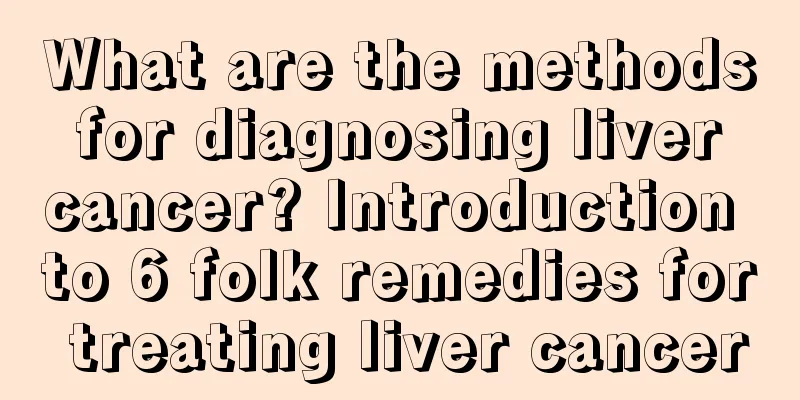What are the methods for diagnosing liver cancer? Introduction to 6 folk remedies for treating liver cancer

|
What are the diagnostic methods for advanced liver cancer? Many people have this question. The early stages of liver cancer are very hidden, with no signs on the surface, so it is rarely treatable. Liver cancer is a common malignant tumor. Once discovered, it is often in the late stages. Regarding the question of what are the diagnostic methods for liver cancer, experts introduce it as follows. 1. Ultrasonography (US): The most commonly used and effective method for liver cancer diagnosis. This method is non-invasive and relatively inexpensive, reusable, has no radioactive damage, and is highly sensitive. However, there are blind spots that are difficult to detect, which are affected by other liver disease backgrounds, as well as the operator's anatomical knowledge, and the meticulousness of the examination and operation. 2. Intraoperative ultrasound imaging: Computerized tomography (CT): A routine item for liver cancer localization diagnosis. The diagnostic value of liver cancer is to clarify the location, number, size and relationship of lesions with important blood vessels; indicate the nature of lesions; help with radiotherapy positioning; and help understand whether there are cancer lesions in the tissues and organs around the liver. 3. Magnetic resonance imaging (MRI): Compared with CT, it can obtain cross-sectional, coronal and sagittal images; it is better than CT in the diagnosis of liver cancer in soft tissue resolution; it has no radiation damage; it is better than CT in differentiating benign and malignant intrahepatic masses, especially hemangiomas. In addition, MRI can show the branches of the portal vein and hepatic vein without enhancement. 4. Hepatic artery angiography: Since Seldinger pioneered the method of percutaneous femoral artery catheterization for visceral angiography in 1953, selective or superselective hepatic artery angiography has become an important means of diagnosing liver cancer. 5. Radionuclide imaging: Radionuclide imaging was an important method for localizing and diagnosing liver cancer in the 1960s and 1970s. However, with the advent of ultrasound, CT, MRI and other imaging methods, radionuclide imaging has fallen behind the former in showing small lesions. In recent years, the diagnosis of liver cancer has regained its importance due to the application of single photon emission computed tomography (ECT) and the use of monoclonal antibodies for radioimmunoassay. 5 diseases are easily misdiagnosed as liver cancer Granuloma: Some female patients may have isolated, smooth, and complete nodules in the liver due to oral contraceptives, parasitic infections, or autoimmune disorders, which are difficult to distinguish from liver cancer on imaging. Ultrasound or CT-guided histological examination is recommended. Cirrhosis nodules: Cirrhosis nodules are most likely to be diagnosed as liver cancer, because most primary liver cancers will develop into cirrhosis, and patients with severe cirrhosis will have a large number of hyperplastic nodules, which are difficult to distinguish from early liver cancer. It is recommended to perform an ultrasound or CT-guided puncture biopsy for accurate diagnosis. Liver abscess: Patients have clinical manifestations such as fatigue, low fever, weight loss, and discomfort in the liver area. It is difficult to differentiate from liver cancer in the early stages of the disease and requires a comprehensive judgment based on biochemical indicators such as blood routine, AFp, and liver function. Hepatic hemangioma: Hepatic hemangioma is easily confused with hepatocellular carcinoma. In fact, hemangioma grows slowly and generally has no history of chronic liver disease. There are no clinical manifestations such as fatigue, poor appetite, abdominal distension, etc., and there will be no physical signs such as liver palms, spider nevi, jaundice, and edema of both lower limbs. Uneven fatty liver: Some patients with fatty liver have uneven fat accumulation, which is sometimes difficult to distinguish from liver cancer. Clinically, fatty liver does not have the systemic manifestations of liver cancer patients, such as abdominal distension, diarrhea, discomfort in the right liver area, and weight loss. Expert comment: If you want to make a clear diagnosis, you should also pay attention to the following risk factors: whether you have a history of chronic hepatitis B or C, whether you have a history of eating or contacting aflatoxin, whether you have a history of long-term alcoholism, and whether you have a family history of liver cancer. In addition, liver cancer patients may have mild icteric sclera, liver palms, and spider nevi; in the middle and late stages, they may have swollen lymph nodes and mild edema in both lower limbs, while patients with benign lesions do not have the above signs. Introduction to 6 folk remedies for treating liver cancer 1. Main symptoms of liver qi stagnation: distension and pain in the right hypochondrium, chest tightness and discomfort, sighing, poor appetite, occasional diarrhea, a lump under the right hypochondrium, a thin white tongue coating, and a stringy pulse. Soothe the liver and strengthen the spleen, regulate qi and activate blood circulation. 2. Main symptoms of damp-heat toxicity: irritability, yellowing of the body and eyes, dry and bitter mouth, decreased appetite, abdominal distension, stabbing pain in the ribs, red urine and dry stools, dark purple tongue, yellow and greasy tongue coating, stringy or slippery pulse. Treatment principle: clear away heat and promote bile secretion, purge fire and detoxify. 3. Traditional Chinese Medicine treatment for primary liver cancer: Astragalus, tortoise shell, turtle shell, Alisma orientalis, Codonopsis pilosula, Atractylodes macrocephala, Poria, Angelica sinensis, Oldenlandia diffusa, Scutellaria barbata. Functions: invigorating Qi and nourishing Yin, clearing away heat and activating blood circulation. Suitable for primary liver cancer. The method of use is decocting in water. 4. Main symptoms of Qi stagnation and blood stasis: huge lumps under the hypochondrium, hypochondrium pain radiating to the back, which is resistant to pressure and worse at night, abdominal distension, loss of appetite, loose and irregular stools, fatigue, dark purple tongue with ecchymosis and petechiae, and deep, thin or stringy and astringent pulse. 5. Liver cancer patients can take selenium supplements appropriately when they are in the late stage. Some patients are zinc-deficient. For people with low selenium, selenium-enriched yeast, selenium polysaccharides, and selenium-enriched salts can be used to supplement selenium and improve blood selenium levels. 6. Liver cancer patients must not smoke or drink alcohol, which is to reduce the intake of nitrosamines. Smoking and drinking are also bad for fatty liver. Drinking wine, beer, and a small amount of alcohol can promote blood circulation and remove blood stasis, but this is not true. Alcohol is harmful to the human body. The gastric mucosa in the stomach has a protective effect on the human body. Alcohol can digest the gastric mucosa, injure the gastric cells, and the toxic substances in the food are easily absorbed by the stomach. |
Recommend
What are not the main causes of primary liver cancer
The main causes of primary liver cancer are hepat...
Why is earwax wet?
If there is too much earwax in the ear canal and ...
What to do if you have severe diarrhea
Diarrhea is the most common digestive system dise...
What will happen to skin cancer in the later stages?
In the late stages of skin cancer, the skin often...
What is the usage and function of sweet noodle sauce?
Nowadays, people are very particular about what t...
What is the best way to eat wolfberry?
Wolfberry has a strong health-preserving function...
Can people with prostate cancer eat soft-shelled turtle
Prostate cancer is a very common disease. For pat...
What should I do if I have a cold and a high fever that won’t go away? It has such a big impact on the fetus
A high fever caused by a cold is extremely harmfu...
Dietary taboos for melanoma
On weekdays, the chance of contracting melanoma i...
There are several methods of abortion surgery
With the advancement of contemporary medical tech...
Is jogging good for patients with teratoma?
Is jogging good for patients with teratoma? Patie...
Heterochromia, two common causes
Heterochromia indicates that there is an abnormal...
Is left shoulder pain a sign of illness?
Shoulder pain is a very common phenomenon for peo...
Wonderful uses for old stockings
Girls' stockings are a symbol of sexiness, bu...
What should I eat when lung cancer reaches the middle and late stages? Recommend 6 lung cancer diet recipes
How long can you live with mid-to-late stage lung...









